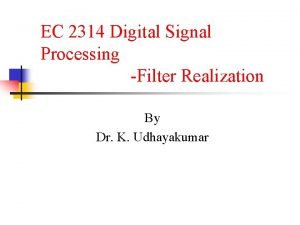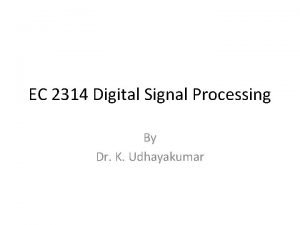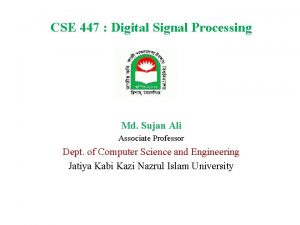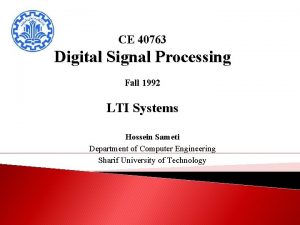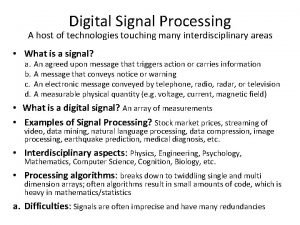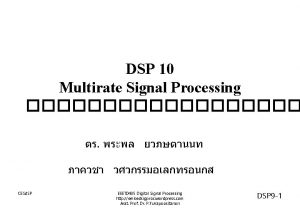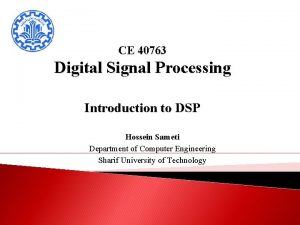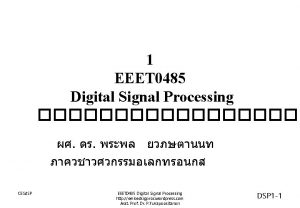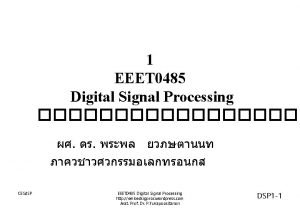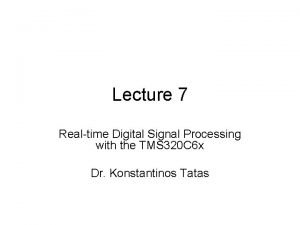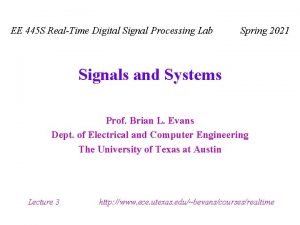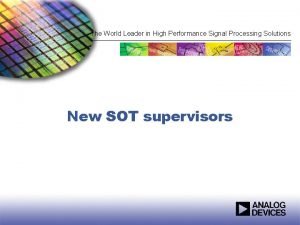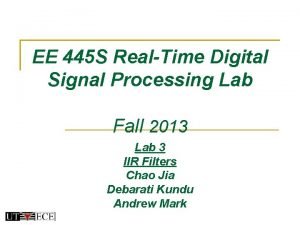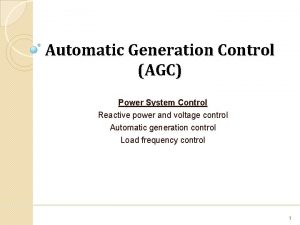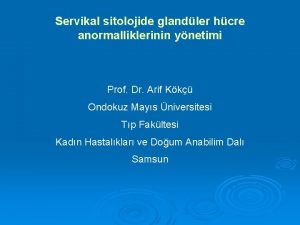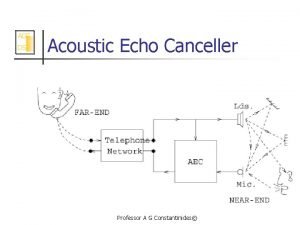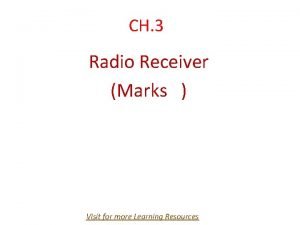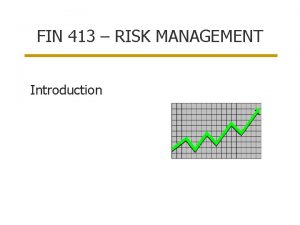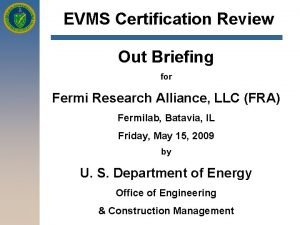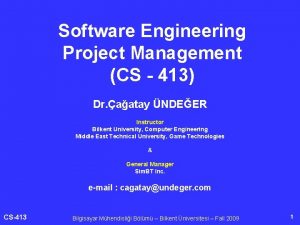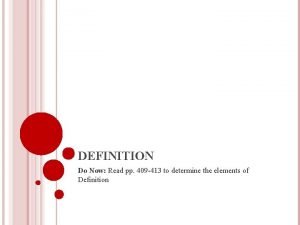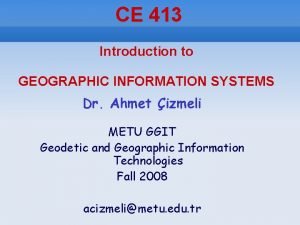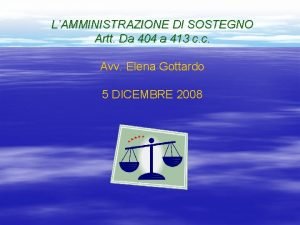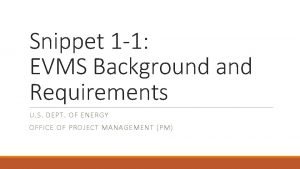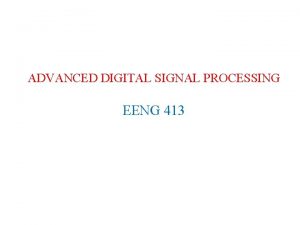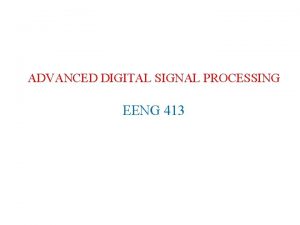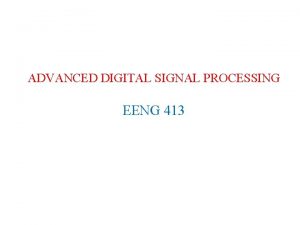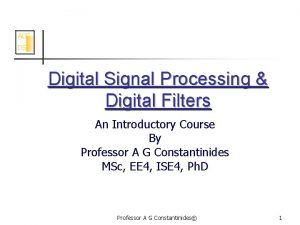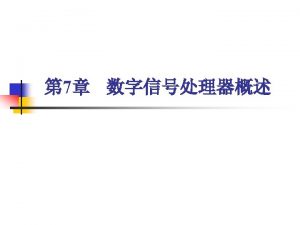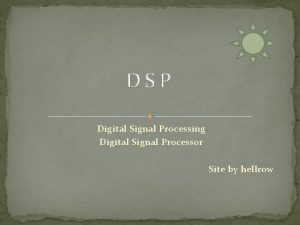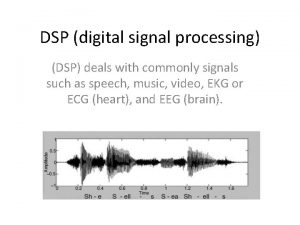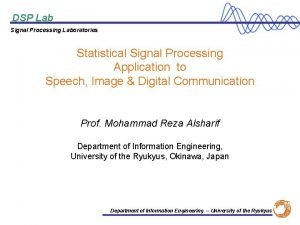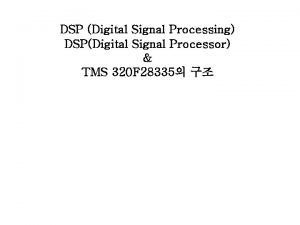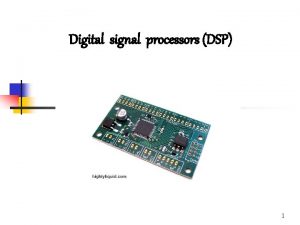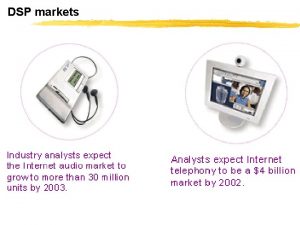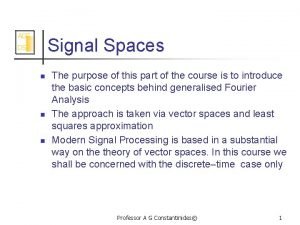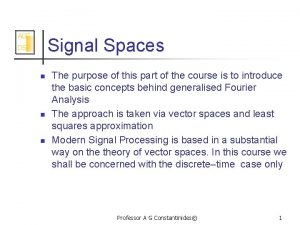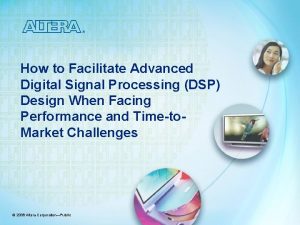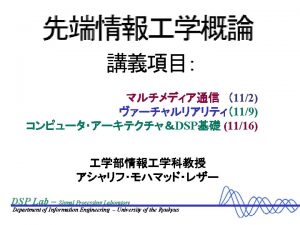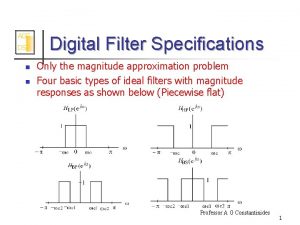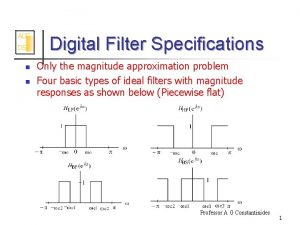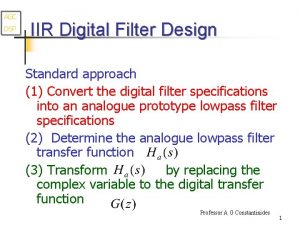ADVANCED DIGITAL SIGNAL PROCESSING EENG 413 AGC DSP








































- Slides: 40

ADVANCED DIGITAL SIGNAL PROCESSING EENG 413

AGC DSP Contents v Unit I Parametric Methods for Power Spectrum Estimation v Unit II Non-Parametric Methods for Power Spectrum Estimation v Unit III Adaptive Signal Processing v Unit IV Multirate Signal Processing v Unit V Discrete Transforms

Reference Books AGC DSP Ø John G. Proakis, Dimitris G. Manobakis, “Digital Signal Processing, Principles, Algorithms and Applications”, Third edition, PHI, 2001. Ø Monson H. Hayes, “Statistical Digital Signal Processing and Modeling”, Wiley, 2002. Ø Roberto Crist, “Modern Digital Signal Processing”, Thomson Brooks/Cole, 2004. Ø Raghuveer. M. Rao, Ajit S. Bopardikar, “Wavelet Transforms, Introduction to Theory and applications”, Pearson Education, Asia, 2000. Ø K. P Soman, K. I Ramachnadran and N. G Reshmi, “Insights into wavelets: From theory to Practice”, 3 rd Edition, PHI, 2010.

AGC Adaptive Signal Processing DSP n n Problem: Equalise through a FIR filter the distorting effect of a communication channel that may be changing with time. If the channel were fixed then a possible solution could be based on the Wiener filter approach We need to know in such case the correlation matrix of the transmitted signal and the cross correlation vector between the input and desired response. When the filter is operating in an unknown environment these required quantities need to be found from the accumulated data.

AGC Adaptive Signal Processing DSP n n n The problem is particularly acute when not only the environment is changing but also the data involved are non-stationary In such cases we need temporally to follow the behaviour of the signals, and adapt the correlation parameters as the environment is changing. This would essentially produce a temporally adaptive filter.

AGC Adaptive Signal Processing DSP n A possible framework is: Algorithm

AGC Adaptive Signal Processing DSP n Applications are many n n n n Digital Communications Channel Equalisation Adaptive noise cancellation Adaptive echo cancellation System identification Smart antenna systems Blind system equalisation And many, many others

AGC DSP Applications

AGC Adaptive Signal Processing DSP n Echo Cancellers in Local Loops Tx 1 Rx 2 Hybrid Echo canceller Adaptive Algorithm Rx 1 Local Loop + Adaptive Algorithm Rx 2 +

AGC Adaptive Signal Processing DSP n Adaptive Noise Canceller REFERENCE SIGNAL FIR filter Noise Adaptive Algorithm Signal +Noise PRIMARY SIGNAL +

AGC Adaptive Signal Processing DSP n System Identification FIR filter Adaptive Algorithm Signal Unknown System +

AGC Adaptive Signal Processing DSP n System Equalisation Signal FIR filter Unknown System Adaptive Algorithm Delay +

AGC Adaptive Signal Processing DSP n Adaptive Predictors Signal FIR filter Delay Adaptive Algorithm +

AGC Adaptive Signal Processing DSP n Adaptive Arrays Linear Combiner Interference

AGC Adaptive Signal Processing DSP n n n Basic principles: 1) Form an objective function (performance criterion) 2) Find gradient of objective function with respect to FIR filter weights 3) There are several different approaches that can be used at this point 3) Form a differential/difference equation from the gradient.

AGC Adaptive Signal Processing DSP n Let the desired signal be The input signal The output Now form the vectors n So that n n

AGC Adaptive Signal Processing DSP n The form the objective function n where

AGC Adaptive Signal Processing DSP n We wish to minimise this function at the instant n Using Steepest Descent we write n But n

AGC Adaptive Signal Processing DSP n n So that the “weights update equation” Since the objective function is quadratic this expression will converge in m steps The equation is not practical If we knew and a priori we could find the required solution (Wiener) as

AGC Adaptive Signal Processing DSP n n n However these matrices are not known Approximate expressions are obtained by ignoring the expectations in the earlier complete forms This is very crude. However, because the update equation accumulates such quantities, progressive we expect the crude form to improve

AGC The LMS Algorithm DSP n Thus we have n Where the error is n And hence can write n This is sometimes called the stochastic gradient descent

AGC DSP Convergence The parameter is the step size, and it should be selected carefully n If too small it takes too long to converge, if too large it can lead to instability n Write the autocorrelation matrix in the eigen factorisation form

AGC Convergence DSP n Where is orthogonal and is diagonal containing the eigenvalues The error in the weights with respect to their optimal values is given by (using the Wiener solution for n We obtain n

AGC Convergence DSP n Or equivalently n I. e. n Thus we have n Form a new variable

AGC Convergence DSP n n n So that Thus each element of this new variable is dependent on the previous value of it via a scaling constant The equation will therefore have an exponential form in the time domain, and the largest coefficient in the right hand side will dominate

AGC Convergence DSP n We require that n Or n In practice we take a much smaller value than this

AGC Estimates DSP n Then it can be seen that as weight update equation yields the n n n And on taking expectations of both sides of it we have Or

AGC Limiting forms DSP n n This indicates that the solution ultimately tends to the Wiener form I. e. the estimate is unbiased

AGC Misadjustment DSP n n The excess mean square error in the objective function due to gradient noise Assume uncorrelatedness set Where is the variance of desired response and is zero when uncorrelated. Then misadjustment is defined as

AGC Misadjustment DSP n It can be shown that the misadjustment is given by

AGC Normalised LMS DSP n n n To make the step size respond to the signal needs In this case And misadjustment is proportional to the step size.

AGC DSP Transform based LMS Algorithm Transform Inverse Transform

AGC Least Squares Adaptive DSP n n with We have the Least Squares solution However, this is computationally very intensive to implement. Alternative forms make use of recursive estimates of the matrices involved.

AGC Recursive Least Squares DSP n n n Firstly we note that We now use the Inversion Lemma (or the Sherman-Morrison formula) Let

AGC Recursive Least Squares (RLS) DSP n Let n Then n The quantity gain is known as the Kalman

AGC Recursive Least Squares DSP n n Now use the filter weights in the computation of From the earlier expression for have And hence updates we

AGC Kalman Filters DSP n n Kalman filter is a sequential estimation problem normally derived from n The Bayes approach n The Innovations approach Essentially they lead to the same equations as RLS, but underlying assumptions are different

AGC Kalman Filters DSP n The problem is normally stated as: n n Given a sequence of noisy observations to estimate the sequence of state vectors of a linear system driven by noise. Standard formulation

AGC Kalman Filters DSP n Kalman filters may be seen as RLS with the following correspondence Sate space n n n Sate-Update matrix Sate-noise variance Observation matrix Observations State estimate RLS

AGC Cholesky Factorisation DSP n n n In situations where storage and to some extend computational demand is at a premium one can use the Cholesky factorisation tecchnique for a positive definite matrix Express , where is lower triangular There are many techniques for determining the factorisation
 Digital signal as a composite analog signal
Digital signal as a composite analog signal Lattice ladder structure of fir filter
Lattice ladder structure of fir filter Quantization error formula
Quantization error formula Dr sujan ali
Dr sujan ali Digital signal processing
Digital signal processing Digital signal processing
Digital signal processing Super audio cd
Super audio cd Digital signal processing
Digital signal processing Digital signal processing
Digital signal processing Digital signal processing
Digital signal processing What is digital signal processing
What is digital signal processing Digital signal processing
Digital signal processing Z transform
Z transform High-performance digital signal processing
High-performance digital signal processing Digital signal processing
Digital signal processing Digital encoding schemes
Digital encoding schemes Histogram processing in digital image processing
Histogram processing in digital image processing Point processing and neighbourhood processing
Point processing and neighbourhood processing Laplacian filter
Laplacian filter Image processing
Image processing Image enhancement point processing techniques
Image enhancement point processing techniques Thinning and thickening in image processing example
Thinning and thickening in image processing example Thermobel
Thermobel Agc power system
Agc power system Agc portage salarial
Agc portage salarial Agv vs agc
Agv vs agc Glandler
Glandler Agc blind
Agc blind Agc perdigones
Agc perdigones Republique du senegal un peuple un but une foi
Republique du senegal un peuple un but une foi Registro de ascensores
Registro de ascensores Double spotting in superheterodyne receivers is caused by
Double spotting in superheterodyne receivers is caused by Fin 413
Fin 413 Why evms certification
Why evms certification Cs 413 bilkent
Cs 413 bilkent Hino 413
Hino 413 What does 413 mean
What does 413 mean 256 en yakın onluğa yuvarlama
256 en yakın onluğa yuvarlama Slidetodoc.com
Slidetodoc.com A 413
A 413 Doe 413 evms
Doe 413 evms

